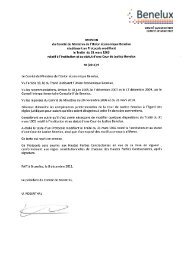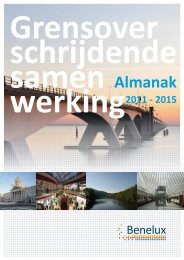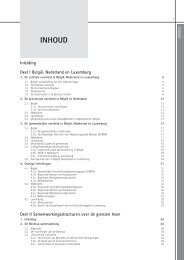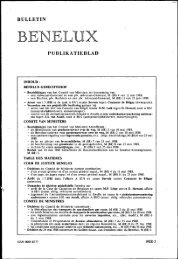The North Seas Countries' Offshore Grid Initiative - Initial ... - Benelux
The North Seas Countries' Offshore Grid Initiative - Initial ... - Benelux
The North Seas Countries' Offshore Grid Initiative - Initial ... - Benelux
You also want an ePaper? Increase the reach of your titles
YUMPU automatically turns print PDFs into web optimized ePapers that Google loves.
<strong>The</strong> principle benefit of this sensitivity study is to compare the radial and meshed designs<br />
for the increased volumes of offshore wind. <strong>The</strong> meshed design for the RES+ case involves<br />
a significant amount of complex offshore meshed network in the <strong>North</strong> Sea, with simpler<br />
meshed networks emerging in the Irish Sea and in the Channel.<br />
<strong>The</strong> location of large wind parks further from the coasts of Great Britain, the Netherlands<br />
and Germany provide an opportunity to create offshore interconnected hubs. One of the<br />
two direct Great Britain-Norway interconnectors and a Germany-Norway interconnector in<br />
the radial designs are replaced in the meshed with a shorter higher capacity<br />
interconnector from Norway to a hub at a large German offshore wind park that is<br />
connected also to a Great Britain offshore hub. This reduces the length of new circuit<br />
required to achieve the interconnection.<br />
<strong>The</strong> offshore grid in the south-west corner of the <strong>North</strong> Sea displays a high degree of<br />
meshing with multiple links to Great Britain, the Netherlands, Belgium and France.<br />
<strong>The</strong> chart in Figure 5-19 presents a comparison of the capital costs of the radial and<br />
meshed network designs. <strong>The</strong>se capital costs should be viewed as indicative only as the<br />
sensitivity analysis has not been as thoroughly studied as the Reference Scenario.<br />
Notwithstanding these precautions, the graph shows that the meshed design results in<br />
higher capital costs of interconnections but lower capital costs for national reinforcements<br />
and offshore wind park connections. <strong>The</strong> meshed grid provides more alternative paths for<br />
power flows from offshore wind parks thereby requiring fewer connections to shore and<br />
fewer onshore reinforcements. Overall, the capital costs of the meshed design are lower<br />
than the radial design by about 7 per cent.<br />
CAPEX [€'m]<br />
60,000<br />
50,000<br />
40,000<br />
30,000<br />
20,000<br />
10,000<br />
RADIAL<br />
Network Design<br />
MESH<br />
Network Design<br />
-<br />
National Network<br />
Reinforcement<br />
National OWP<br />
Connection<br />
Interconnection Total<br />
10,579 35,026 11,547 57,153<br />
9,209 29,893 13,988 53,090<br />
Figure 5-19 : Comparison of Investment Costs for radial and meshed grid design for RES+ sensitivity on<br />
the Reference Scenario<br />
Page 56 of 142










